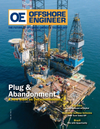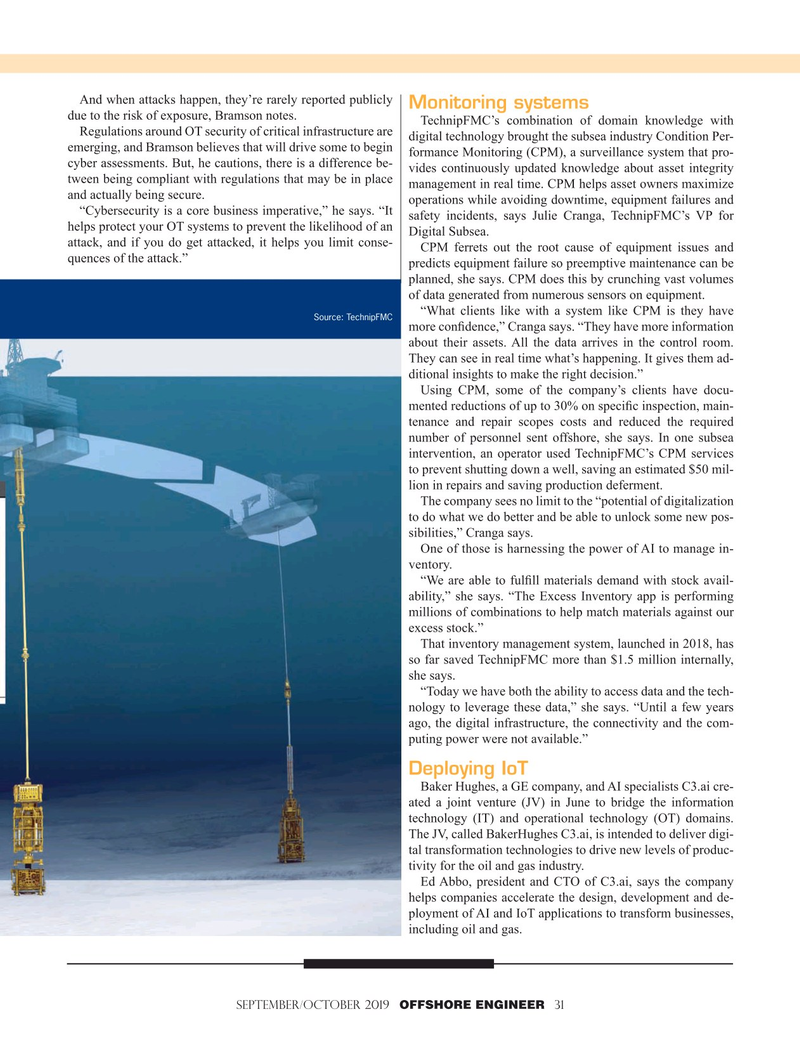
Page 31: of Offshore Engineer Magazine (Sep/Oct 2019)
Big Data and Digitalization
Read this page in Pdf, Flash or Html5 edition of Sep/Oct 2019 Offshore Engineer Magazine
And when attacks happen, they’re rarely reported publicly
Monitoring systems due to the risk of exposure, Bramson notes.
TechnipFMC’s combination of domain knowledge with
Regulations around OT security of critical infrastructure are digital technology brought the subsea industry Condition Per- emerging, and Bramson believes that will drive some to begin formance Monitoring (CPM), a surveillance system that pro- cyber assessments. But, he cautions, there is a difference be- vides continuously updated knowledge about asset integrity tween being compliant with regulations that may be in place management in real time. CPM helps asset owners maximize and actually being secure.
operations while avoiding downtime, equipment failures and “Cybersecurity is a core business imperative,” he says. “It safety incidents, says Julie Cranga, TechnipFMC’s VP for helps protect your OT systems to prevent the likelihood of an
Digital Subsea. attack, and if you do get attacked, it helps you limit conse-
CPM ferrets out the root cause of equipment issues and quences of the attack.” predicts equipment failure so preemptive maintenance can be planned, she says. CPM does this by crunching vast volumes of data generated from numerous sensors on equipment. “What clients like with a system like CPM is they have
Source: TechnipFMC more con? dence,” Cranga says. “They have more information about their assets. All the data arrives in the control room.
They can see in real time what’s happening. It gives them ad- ditional insights to make the right decision.”
Using CPM, some of the company’s clients have docu- mented reductions of up to 30% on speci? c inspection, main- tenance and repair scopes costs and reduced the required number of personnel sent offshore, she says. In one subsea intervention, an operator used TechnipFMC’s CPM services to prevent shutting down a well, saving an estimated $50 mil- lion in repairs and saving production deferment.
The company sees no limit to the “potential of digitalization to do what we do better and be able to unlock some new pos- sibilities,” Cranga says.
One of those is harnessing the power of AI to manage in- ventory. “We are able to ful? ll materials demand with stock avail- ability,” she says. “The Excess Inventory app is performing millions of combinations to help match materials against our excess stock.”
That inventory management system, launched in 2018, has so far saved TechnipFMC more than $1.5 million internally, she says. “Today we have both the ability to access data and the tech- nology to leverage these data,” she says. “Until a few years ago, the digital infrastructure, the connectivity and the com- puting power were not available.”
Deploying IoT
Baker Hughes, a GE company, and AI specialists C3.ai cre- ated a joint venture (JV) in June to bridge the information technology (IT) and operational technology (OT) domains.
The JV, called BakerHughes C3.ai, is intended to deliver digi- tal transformation technologies to drive new levels of produc- tivity for the oil and gas industry.
Ed Abbo, president and CTO of C3.ai, says the company helps companies accelerate the design, development and de- ployment of AI and IoT applications to transform businesses, including oil and gas.
September/OctoBER 2019 OFFSHORE ENGINEER 31

 30
30

 32
32